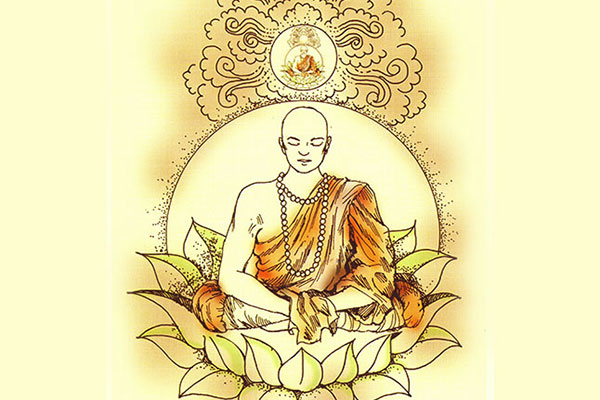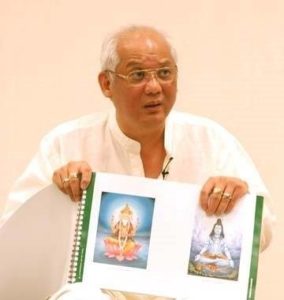In a previous article, we discussed what exactly is Yoga. However, we do hear about multiple types of yoga.
Classically, there are seven different types of yoga – Bhakti yoga, Raja Yoga, Kundalini Yoga (sometimes called Laya Yoga), Jnana Yoga, Karma Yoga, Mantra Yoga, and Hatha Yoga. There are also many “new age” (for the lack of a better term) varieties of yoga.
Have you ever wondered why there are so many forms of yoga? Possibly, it is because so many different paths lead to the same destination.

The Pursuit of Yoga
The primary objective of yoga is to achieve self-realization or soul-realization – or what Master Choa has referred to as the union between the Incarnated Soul and the Higher Soul. In Sanskrit, this state is known as Samadhi.
Having achieved self-realization or soul-realization, the goal of Yoga shifts to what is called God-realization – or what is technically the union between the Soul and the Divine Spark. Just like there are many stages of self-realization, God-realization also has many stages, i.e., a soul can be partially God-realized or Fully God-realized. This is the “higher form” of yoga, which in the Bhagavad Gita has been described as the science of uniting the ‘Individual Consciousness’ with the ‘Ultimate Consciousness.’
The Bhagavad Gita also specifies that this process can be accelerated using many methods and different types of Yoga, i.e., there are multiple paths to achieving this union.
Demystifying the Types of Yoga
Classically, there are 7 types of Yoga. It must be borne in mind that no one type is better than another type. Each type of yoga has its purpose and contributes towards achieving the ultimate goal – union. So, let’s try to understand the differences between the various types of yoga and what they are intended to do.
Bhakti Yoga: Bhakti Yoga is the yoga of love and also of devotion. It includes bhakti practices like praising the supreme god, chants, prayers, and songs. Bhakti Yoga aims to develop the spiritual practitioner’s love aspect or heart. Esoterically, Bhakti Yoga develops the heart chakra, which subsequently activates the crown chakra (the entry point of divine consciousness), thereby allowing the practitioner to achieve illumination. As MCKS taught, “When the crown chakra is not activated, the connection (of the incarnated soul) with the higher soul is minimal.” In the Arhatic Yoga system, Bhakti Yoga corresponds to the Meditation on the Twin Hearts. The ‘Meditation on the Twin Hearts’ is, in fact, the foundation for spiritual development, given that spiritual progress is challenging without the development of a loving heart and qualities such as compassion, patience, tolerance, sweetness, generosity, and other aligned qualities. As MCKS taught, the “Meditation on Twin Hearts creates a bridge between the emotional love of the incarnated soul and the divine love of the higher soul.” This is possibly the reason why this meditation is introduced in the first workshop (Basic Pranic Healing).
Raja Yoga: Raja Yoga literally translates to Royal Yoga or Yoga of a King. It offers a comprehensive method for developing the will aspect and controlling the mind through concentration and meditation. In the Arhatic Yoga System, this corresponds to the Meditation on the Higher Soul and is introduced in the Achieving Oneness with Your Higher Soul workshop. Raja Yoga or ‘Meditation on the Higher Soul’ entails concentration and awareness on the ‘blue pearl’ or the ‘seed of consciousness.’ As MCKS taught, “Awareness helps you to listen to the subtle voice, the whisper of your higher soul. You become aware of your Buddha nature, your soul.”
Kundalini Yoga: Kundalini Yoga is sometimes also referred to as Laya Yoga and derives its name from a focus on awakening the Kundalini Energy (a subject that has been covered in detail in a previous article) and using that energy to upgrade the physical body, nervous system and the brain. Powerful techniques of Kundalini Yoga are introduced in the Arhatic Yoga (Preparatory Level) through the practices of ‘Meditation on the Inner Breath’ and the ‘Arhatic Dhyan.’ Subsequent “upgrades” are provided in the Higher Levels of Arhatic Yoga. Without sufficient awakening of the Kundalini energy, spiritual progress in general would be slow. Thus, Kundalini Yoga is an important stepping stone for rapidly achieving soul realization.
Jnana Yoga: Jnana Yoga is literally the ‘Yoga of Wisdom and Understanding.’ The objective of Jnana Yoga is to develop the intelligence aspect of the practitioner – given that a sharp mind is needed to understand who we really are. Note that here, we are not referring to only intellectual knowledge but spiritual knowledge. According to MCKS, “This path (Jnana Yoga) is the easiest path for those who are mentally developed.” With access to suitable material to study, “there will be a greater downpour of spiritual energy” and, therefore, faster spiritual development. Ever wondered why sacred teachings (as contained in esoteric books belonging to many traditions) are kept so veiled and secret? This has been done to protect students who are not mature enough to access the teachings. In the Arhatic Yoga system, Jnana Yoga is introduced as the ‘Understanding Meditation’ in Arhatic Yoga Level 1.
Karma Yoga: The word Karma means action. Karma Yoga is literally ‘Yoga of Action.’ Karma Yoga is essentially a path that seeks union using selfless service to humanity. In this practice, one is seen as being used as an instrument of service in the hands of the Great Ones. MCKS taught: “Service, together with meditation, is one of the fastest ways to achieve illumination. The greater your service, the greater your spiritual development. When you do service, your energy level increases. You become a channel. The more you do service, the more you become empowered. It is a faster way to develop than meditating alone in the mountains.” This is one of the reasons why many spiritual teachers throughout history have healed people and have set up noble, humanitarian, and charitable projects. In the Arhatic Yoga system, the ‘Concretization Meditation’ is taught in Arhatic Yoga Level 2 to aid in practicing Karma Yoga.
Mantra Yoga: A mantra is a word of power. Not only are words such as “Om,” “Amen,” and “Amin” sacred, but they also carry with them tremendous spiritual power. Mantras can be used for multiple purposes, including inner purification, empowerment, and raising the consciousness to a higher plane. These sacred sounds (when used scientifically and adequately) can also accelerate self-development and spiritual development. No wonder MCKS left us many recordings of mantras to be used to further our spiritual practices.
Hatha Yoga: The word Haṭha literally means “force” and thus alludes to a system of physical techniques. In the 20th century, Hatha yoga, particularly asanas (the physical postures), became popular throughout the world as a form of physical exercise and is now colloquially termed as simply “yoga.” Hatha Yoga has several purposes. Asanas cleanse the aura, chakras, and energy channels, enabling spiritual energy to circulate without obstructions. This is because Hatha Yoga has a cleansing effect (both physically and etherically). Physically, waste matter and toxins are eliminated through sweating. Energetically, the chakras and aura are cleansed of used-up energy and diseased energy. Hatha Yoga also enables the practitioner to strengthen the body to allow the physical vehicles to cope with a greater down-pouring of spiritual energy. Without a strong and healthy body, it would be difficult to proceed on the spiritual path, given that the quantum of spiritual energies that you can pull down is limited in part by the ability of the physical body and organs to withstand energies. On a deeper level, Hatha Yoga helps discipline the physical vehicles by asserting the will aspect of the soul. Simplified Hatha Yoga (along with several types of pranayama or breathing techniques) are taught in Arhatic Yoga to condition and prepare the energy bodies of the practitioner to handle the energy generated by various meditations.
Arhatic Yoga: The Yoga of Synthesis
Arhatic Yoga is sometimes referred to as the synthesis of yoga. This is because it systematically integrates all the 7 yoga’s into the practice. The multi-dimensional approach also manifests as the all-round development of the soul’s love, will, and intelligence aspects, thereby accelerating the achievement of the ultimate goal – spiritual oneness.
The power of Arhatic Yoga is beyond imagination. Practice it diligently for 2-3 years and see a drastic transformation in yourself and all facets of your life. Don’t take our word for it. Try it yourself.


Thought provoking and motivational feeling.. thanku 😃